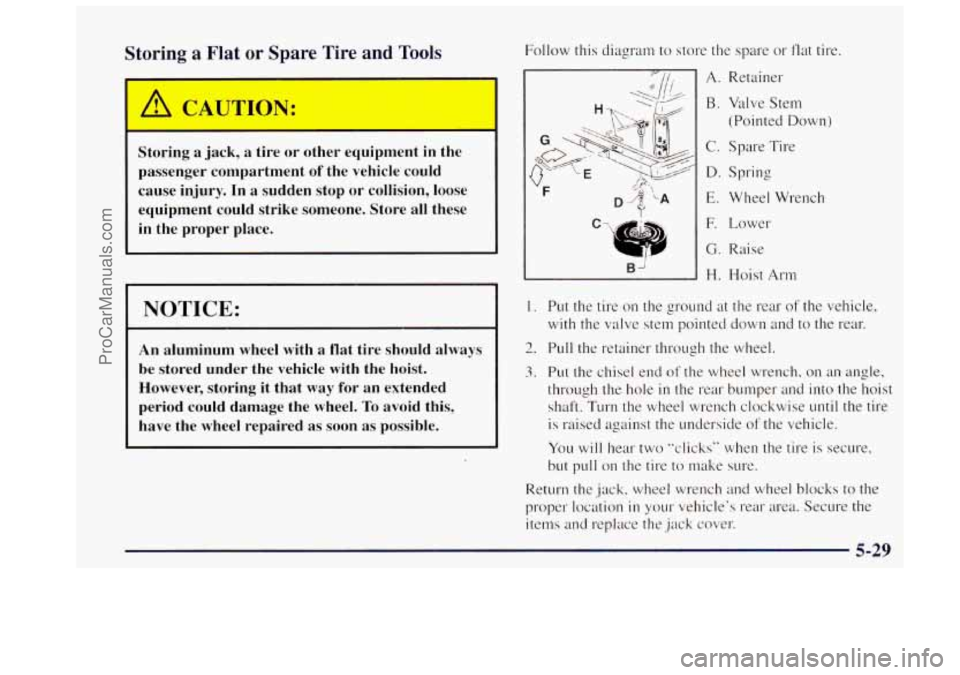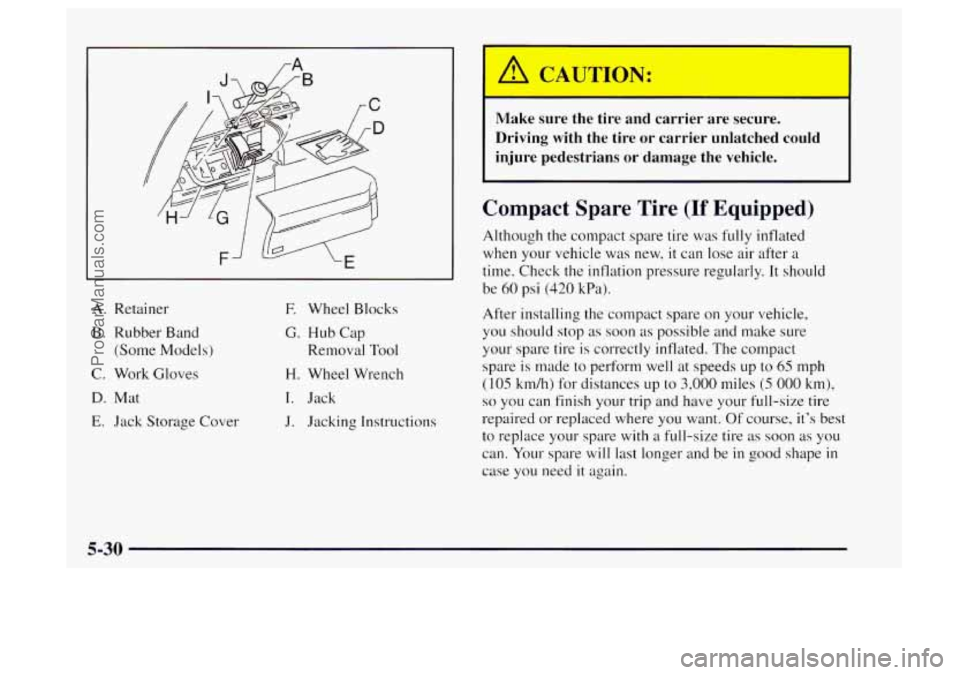Page 148 of 358

Before You Go Off-Roading
There are some things to do before you go out. For
example, be sure to have all necessary maintenance and
service work done. Check to make sure all underbody
shields (if
so equipped) are properly attached. Be sure
you read all the information about your
four-wheel-drive vehicle in this manual.
Is there enough
fuel?
Is the spare tire fully inflated? Are the fluid levels
up where they should be? What are the local laws that
apply to off-roading where you’ll be driving? If you
don’t know, you should check with law enforcement
people in the area. Will you be on someone’s private
land? If
so, be sure to get the necessary permission.
Loading Your Vehicle for Off-Road Driving
There are some important things to remember about
how to load your vehicle.
0 The heaviest things should be on the load floor and
forward of your rear axle. Put heavier items as far
forward as you can.
0 Be sure the load is secured properly, so driving on
the off-road terrain doesn’t toss things around.
0 Cargo on the load floor piled higher than
the seatbacks can be thrown forward
during
a sudden stop. You or your
passengers could be injured. Keep cargo
below the top of the seatbacks.
0 Unsecured cargo on the load floor can be
tossed about when driving over rough
terrain. You or your passengers can be
struck by flying objects. Secure the
cargo properly.
0 Heavy loads on the roof raise the vehicle’s
center of gravity, making
it more likely to
roll over. You can be seriously or fatally
injured if the vehicle rolls over. Put heavy
loads inside the cargo area, not on the roof.
Keep cargo in the cargo area
as far forward
and low
as possible.
You’ll find other important information in this manual.
See “Vehicle Loading,” “Luggage Carrier” and “Tires’’
in the Index.
ProCarManuals.com
Page 187 of 358
Section 5 Problems on the Road
Here you’ll find what to do about some problems that can occur on the road.
5-2
5-3
5-3
5-7
5- 10
5-11
5-12
5- 12
5- 14 How
to Use
Warning Flashers
Other Types of Warning Devices
Step-by-step Procedure for Jump Starting
Information You Should Know Before Towing
Towing Your Vehicle From the Front
Towing Your Vehicle From the Rear
If Your Engine
is Overheating
If Steam is Coming From Your Engine
Cooling System 5-16
5-21
5-21
5-29
5-30
5-3 1
5-32
5-32 How to Add
Coolant
What to do if a Tire Goes Flat
How to Change a Flat Tire
Where to Store the Flat Tire and Tools
Information on the Compact Spare Tire
If You’re Stuck in Sand, Mud, Snow or on Ice
How to Rock Your Vehicle to Get Unstuck
Using Recovery Hooks
5-1
ProCarManuals.com
Page 208 of 358
Removing the Spare Tire and Tools
The jacking equipment you’ll need is stored along the
driver’s rear wall. Your vehicle
is also equipped with
work gloves
and a plastic ground mat to assist in the
changing
of a flat tire.
To remove the jack
cover, pull
up on the
latch
at the end of the
cover, near the endgate.
Then pull up
on the latch on the top of the cover.
Remove the wheel blocks, jack and wheel wrench.
The spare tire
is stored under the vehicle.
I NOTICE:
Never remove or restow a tire frodto a stowage
position under the vehicle while the vehicle
is
supported by a jack. Always tighten the tire fully
against the underside of the vehicle when
restowing.
5-22
ProCarManuals.com
Page 209 of 358
Turn the wheel wrench counterclockwise to lower the
spare tire. Keep turning the wheel wrench
until the spare
tire can be pulled out from under the vehicle.
When the tire has been completely lowered,
tilt the
retainer at the end
of the cable and pull it through the
wheel opening. Pull the tire out from under the vehicle.
I NOTICE:
To help avoid vehicle damage, do not drive the
vehicle before the cable is restored.
A
Put the spare tire near the flat tire.
The tools you'll be using include the jack (A), the wheel
wrench
(B) and the hub cap removal tool (C).
You will have to take off the hub cap to reach your
wheel nuts.
5-23
ProCarManuals.com
Page 210 of 358
Position the hub cap removal tool in the notch and pull
straight away from the wheel to avoid potential damage
to the hub cap and wheel surface. Remove the hub cap.
Removing the Flat Tire and Installing the
Spare Tire
1. Using the wheel wrench, loosen all the wheel nuts.
Don’t remove them yet.
2. Turn the jack handle clockwise to raise the jack
lift head.
3. Fit the jack into the appropriate hole nearest the
flat tire.
5-24
ProCarManuals.com
Page 212 of 358
4. Raise the vehicle by turning the jack handle clockwise.
Raise the vehicle
far enough off the ground so there is
enough
room for the spare tire to fit.
5. Remove all the wheel nuts and take off the flat tire.
6. Remove any rust or dirt
from the wheel bolts,
mounting surfaces and
spare wheel.
'
A CAUT 3%
I
Rust or dirt on the wheel, or on the parts to
which it is fastened, can make the wheel nuts
become loose after a time. The wheel could come
off and cause an accident. When
you change a
wheel, remove any rust or dirt from the places
where the wheel attaches to the vehicle.
In an
emergency, you can use a cloth or a paper towe
to do this; but be sure to use a scraper or wire
brush later,
if you need to, to get all the rust or
dirt
off.
!I
5-26
ProCarManuals.com
Page 215 of 358

Storing a Flat or Spare Tire and Tools
' CAT' I ION:
Storing a jack, a tire or other equipment in the
passenger compartment of the vehicle could
cause in.jury. In a sudden stop
or collision, loose
equipment could strike someone. Store
all these
in the proper place.
An aluminum wheel with a flat tire should always
be stored under the vehicle with the hoist.
However, storing it that way for an extended
period could damage the wheel.
To avoid this,
have the wheel repaired as soon as possible. Follow this diagram
to store the spare or flat tire.
BJ
A. Retainer
B. Valve
Stem
(Pointed Down)
C. Spare Tire
D. Spring
E. Wheel Wrench
F. Lower
G. Raise
H. Hoist
Arm
1. Put the tire on the ground at the rear of the vehicle.
with the valve stem pointed down and to the rear.
2. P~dl the retainer through the wheel.
3. Put the chisel end of the wheel wrench. on an angle,
through the hole
in the rear bumper and into the hoist
shaft. Turn the wheel wrench clockwise
until the tire
is raised against the underside of the vehicle.
You will hear two "clicks" when the tire is secure,
but pull on the tire to make sure.
Return
the jack. wheel wrench and wheel blocks to the
proper location
in your vehicle's rear area. Secure the
items and replace the
jack cove]:
5-29
- _-
ProCarManuals.com
Page 216 of 358

h CAUTION:
--
Make sure the tire and carrier are secure.
Driving with the tire or carrier unlatched could
injure pedestrians or damage the vehicle.
rA
A. Retainer
B. Rubber Band
(Some Models)
C. Work Gloves
D. Mat
E. Jack Storage Cover
E Wheel Blocks
G. Hub Cap
Removal Tool
H. Wheel Wrench
I. Jack
J. Jacking Instructions
Compact Spare Tire (If Equipped)
Alt.hough the compact spare tire was fully inflated
when your vehicle was new, it can lose air after
a
time. Check the inflation pressure regularly. It should
be
60 psi (420 kPa).
After installing the compact spare on your vehicle,
you should stop as soon as possible and make sure
your spare tire
is correctly inflated. The compact
spare is made to perform well at speeds up to
65 mph
(105 km/h) for distances up to 3,000 miles (5 000 km),
so you can finish your trip and have your full-size tire
repaired or replaced where you want. Of course, it’s best
to replace your spare with a full-size tire as soon as you
can. Your spare will last longer and be
in good shape in
case you need it again.
5-30
ProCarManuals.com